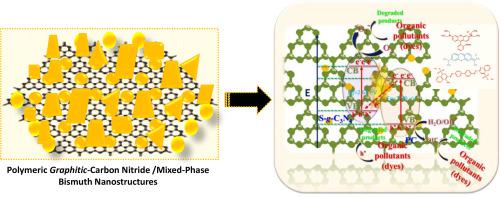NanoImpact ( IF 4.7 ) Pub Date : 2021-08-10 , DOI: 10.1016/j.impact.2021.100345 Akbar Mohammad 1 , Mohammad Ehtisham Khan 2 , Moo Hwan Cho 1 , Taeho Yoon 1

|
To enhance the activities of advanced semiconductor photocatalysts, the charge carriers must be separated effectively. One strategy for achieving this is the use of heterogeneous structures, which can be prepared by hydrothermal synthesis and post-synthetic thermal and ultrasonic treatment. Herein, we report a mixed-phase composite of basic bismuth nitrate/pentabismuth heptaoxide nitrate (PC) prepared by hydrothermal synthesis under basic conditions and post-synthetic thermal treatment. In addition, sulfur-doped-graphitic carbon nitride (S-g-C3N4) was prepared and combined with PC in different ratios, denoted as PC-1, PC-2, and PC-3, using sonication-assisted treatment. The characterization of these catalysts confirmed the formation of mixed basic bismuth nitrate/pentabismuth heptaoxide nitrate phases and the composite nanostructure. The developed nanostructure showed interesting morphological features, for example, layered sheets of S-g-C3N4. The prepared PCs were tested for their visible light responsiveness for the photocatalytic degradation of a representative organic dye (Rhodamine B). We found that the modified photocatalysts showed superior activity to that of pristine PC. The optimal photocatalyst (PC-3) was also used to degrade methylene blue and Congo red, achieving 99% degradation. Thus, we present not only an efficient photocatalyst but also insights into the post-synthetic modification of basic bismuth nitrate/pentabismuth heptaoxide nitrate with stable carbon-based nanostructures.
中文翻译:

基于石墨-氮化碳的混合相铋纳米结构:在可见光照射下具有增强的光催化性能的调谐光学和结构特性用于废水净化
为了提高先进半导体光催化剂的活性,必须有效地分离载流子。实现这一目标的一种策略是使用异质结构,可以通过水热合成和合成后热处理和超声波处理来制备。在此,我们报告了通过在碱性条件下水热合成和合成后热处理制备的碱性硝酸铋/七氧化二氧化五铋(PC)的混合相复合材料。此外,硫掺杂石墨氮化碳(S- g -C 3 N 4) 使用超声辅助处理制备并以不同比例与 PC 组合,表示为 PC-1、PC-2 和 PC-3。这些催化剂的表征证实了混合碱性硝酸铋/五氧化二硝酸铋相和复合纳米结构的形成。开发的纳米结构显示出有趣的形态特征,例如 S- g -C 3 N 4的层状薄片. 测试了制备的 PC 对代表性有机染料(罗丹明 B)的光催化降解的可见光响应性。我们发现改性光催化剂表现出优于原始 PC 的活性。最佳光催化剂(PC-3)也用于降解亚甲蓝和刚果红,降解率达到99%。因此,我们不仅提供了一种高效的光催化剂,而且还深入了解了具有稳定碳基纳米结构的碱性硝酸铋/七氧化五铋硝酸盐的后合成改性。











































 京公网安备 11010802027423号
京公网安备 11010802027423号